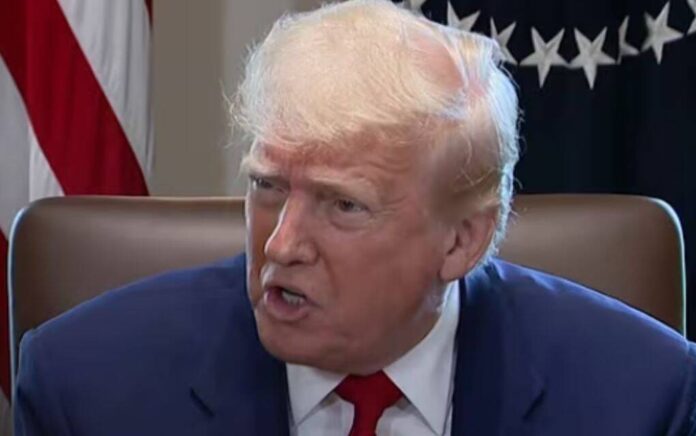
Donald Trump is a shaker and mover. There’s nothing sacred or off limits in the D.C. Swamp for him.
And President Trump just sent a demand to Congress that’s left all of D.C. utterly speechless.
President Trump Eyeing Massive Non-Defense Spending Cuts
President Donald Trump has ignited a fiscal revolution with his 2026 budget proposal, unveiled Friday morning, aiming to carve out over $160 billion in non-defense spending. This audacious plan signals a return to fiscal discipline, targeting a bloated federal government that has long drifted from its core responsibilities. By slashing non-defense discretionary spending by 22.6% below 2025 levels, Trump’s blueprint seeks to restore efficiency, prioritizing national security and economic stability over wasteful programs. The move is a clarion call to Congress: rein in spending or risk the nation’s financial future.
The proposal, crafted with input from the Department of Government Efficiency, zeroes in on eliminating government waste. It builds on Trump’s campaign promises to downsize a federal bureaucracy that has ballooned under previous administrations. The cuts would bring non-defense spending to its lowest since 2017, a deliberate step to curb programs that have little to do with serving the American people. Instead, the budget channels resources toward defense and border security, areas Trump deems essential for a strong and sovereign nation.
Russ Vought, director of the White House Office of Management and Budget, minced no words in a letter to Senate Appropriations Committee chair Susan Collins. He described the targeted programs as “tilted toward funding niche non-governmental organizations and institutions of higher education committed to radical gender and climate ideologies antithetical to the American way of life.” Vought’s critique resonates with conservatives who see these initiatives as disconnected from the needs of everyday Americans, diverting taxpayer dollars to ideological pet projects.
Congress faces a tight deadline to approve Trump’s budget by September 30, setting the stage for a contentious battle on Capitol Hill. The proposal’s aggressive cuts, averaging 35% across many government agencies, are likely to spark resistance from Democrats and moderate Republicans. Yet, for Trump and his allies, these reductions are non-negotiable. The overall discretionary spending cut of 7.6% is a calculated move to shrink a government that has grown unchecked, while still preserving critical functions.
Defense spending, a cornerstone of Trump’s vision, would surge by 13% to over $1 trillion in 2026. Senior OMB officials called this increase “historic,” emphasizing its role in strengthening America’s military might. Similarly, the Department of Homeland Security would see a 65% funding boost to support Trump’s aggressive border security and deportation policies. These investments signal a clear priority: protecting the nation’s borders and ensuring its safety in an increasingly volatile world.
Trump says a total tax cut could be coming.
"We're gonna cut taxes for the people of this country. It'll take a little while… I think the tariffs will be enough to cut all of the income tax." 👀 pic.twitter.com/QkKF0ShpTG
— Sara Rose 🇺🇸🌹 (@saras76) April 27, 2025
One of the proposal’s most striking features is the cancellation of over $20 billion in funds from the Infrastructure Investment and Jobs Act, which Trump’s team derides as the “Green New Scam.” The Biden-era law, touted as a landmark achievement, allocated billions for initiatives like the Department of Transportation’s electric vehicle charging grant program. Trump’s budget axes these funds, arguing they represent government overreach into markets better left to private enterprise.
The White House fact sheet is unequivocal: “EV chargers should be built just like gas stations: with private sector resources disciplined by market forces.” This stance aligns with Trump’s free-market philosophy, which favors innovation driven by competition over government subsidies. By redirecting these funds, the administration aims to free up resources for priorities that directly benefit American taxpayers, rather than propping up niche environmental agendas.
Conservative lawmakers have rallied behind the proposal, praising its focus on fiscal restraint. Republican Texas Rep. Chip Roy hailed it as a “transformational budget” that preserves robust defense funding while slashing “woke, weaponized, and wasteful bureaucracy by 20% even farther back than pre-COVID levels.” Roy’s enthusiasm is shared by congressional Republicans eyeing even deeper cuts—potentially $1.5 trillion or more—in a comprehensive bill that could reshape federal spending for decades.
House Budget Committee chairman Jodey Arrington echoed Roy’s sentiments, commending Trump’s unwavering commitment to fiscal responsibility. “President Trump’s budget reflects his bold and unwavering commitment to reining in Washington’s runaway spending, right sizing the bloated federal bureaucracy, and putting our nation on a path to balance,” Arrington said. His statement captures the optimism among conservatives that Trump’s leadership can reverse years of reckless budgeting.
The budget’s emphasis on extending and expanding Trump’s tax cuts, alongside reforms to programs like Medicaid, further cements its pro-growth agenda. These measures aim to reduce deficits while fostering economic prosperity, a dual goal that resonates with voters weary of Washington’s spendthrift ways. By pairing spending cuts with tax relief, Trump is betting that a leaner government will unleash American ingenuity and drive long-term growth.
With defense and border security fortified, and wasteful programs on the chopping block, the plan offers a clear path to a balanced budget. The question now is whether lawmakers will seize this opportunity to restore fiscal sanity or cling to the status quo.



















